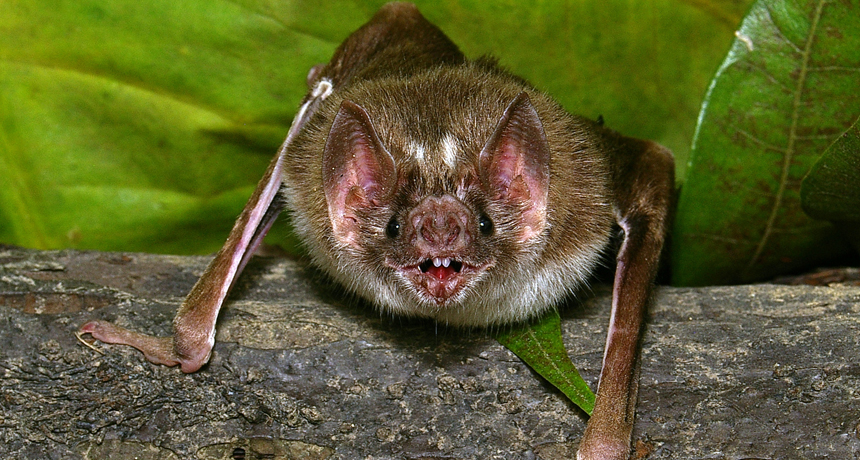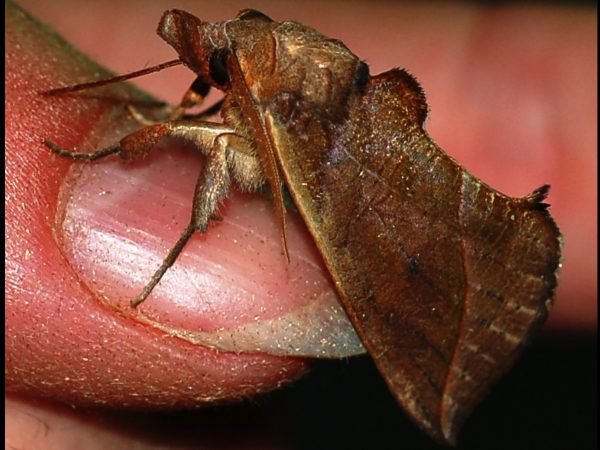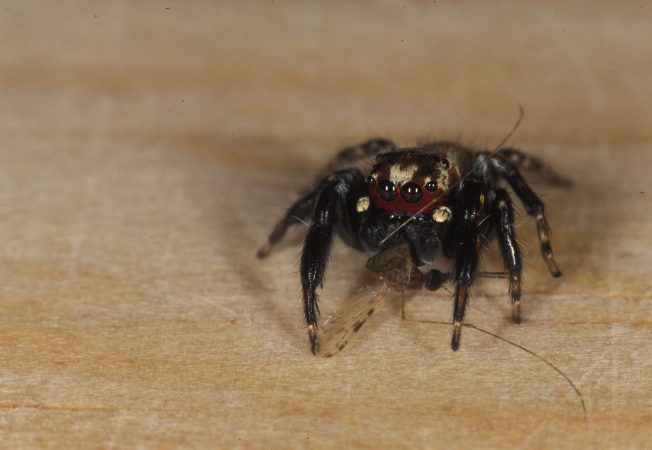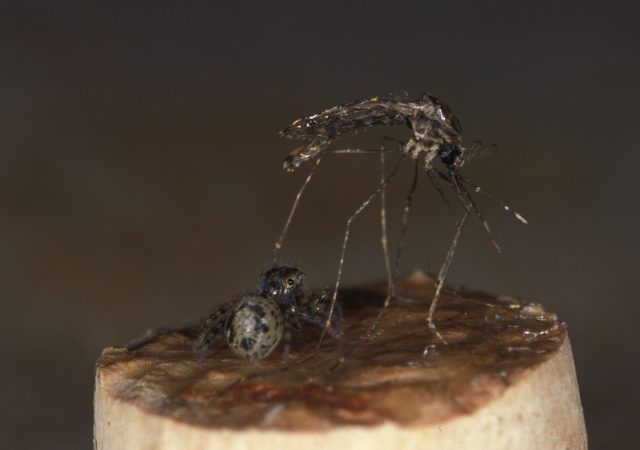True vampires
Bats are far from the only creatures to feast on blood

To survive, the vampire bat must feed on animals such as cows, pigs and birds. Their blood is the bat’s sole source of food.
Pascual Soriano, Universidad de los Andes
By Roberta Kwok
In 2006, a vampire bit Jennifer Zaspel. No, not the fantasy kind, with a pasty face, black cape and sharp teeth. This vampire was real — and a moth.
Zaspel is a biologist who studies insects at Purdue University in West Lafayette, Ind. She had flown to Russia in search of a moth called Calyptra thalictri. These bugs drink the juice of fruit, such as grapes, raspberries and peaches. To do so, the insect pokes a long, strawlike mouthpart called a proboscis (Pra BOH sis) into the fruit’s skin. Once inside, it sucks out the sweet juice.
Juice isn’t all that some of these moths drink. While walking through a river valley in eastern Russia, Zaspel trapped one of the moths in a plastic vial. Curious to see what the bug would do, she stuck her thumb into the container. “Within a matter of minutes, it started feeding on me,” she says. The moth drilled its proboscis into her skin and began drinking her blood.

Being a bloodsucker isn’t easy. These critters must develop clever ways to select and attack their prey. And just as old Dracula aimed for the neck, some creatures carefully choose where they bite to ensure they get the biggest meal.
From fruit to blood
The moth that Zaspel encountered in Russia is not the first known bloodsucker moth. Some related species also drink the blood of animals, including elephants and rhinoceroses. Other Calyptra moths eat only fruit.
Even within the species C. thalictri, only some moths will drink blood. Zaspel’s team collected 16 of these moths in Russia. Each moth got a chance to pierce the thumb of one of the researchers. Just three moths chose to drink a scientist’s blood. Others didn’t even try to pierce a researcher’s skin.
Zaspel wondered how the blood-feeding moths differed from those that ate only fruit. Maybe the bloodsuckers had evolved special proboscis features.
To investigate, Zaspel compared these mouthparts in C. thalictri moths that did drink blood with those in others that did not. In both, the proboscis resembled two straws stuck together, with hooks and barbs that help the insect pierce fruit or animal tissue. Zaspel looked for differences in the shapes of the hooks and barbs but didn’t see any.
So her fellow scientists next focused on the insects’ antennae. Moths use these organs like noses to pick up important scents. Tiny hairlike structures on the antennae, called sensilla, detect odors.
Using a microscope, the researchers counted the sensilla on each antenna. Bloodsucking moths had fewer sensilla than did members of their species that that dined only on fruit.
Fewer sensilla might make moths less sensitive to the smell of animals. In fact, the moths that ate only fruit often seemed repulsed when offered a researcher’s thumb. They turned away or tried to escape. In contrast, bloodsucking moths might not detect an animal’s scent very well. That could make a thumb much less repellent as a choice for dinner.
Zaspel thinks that blood-feeding evolved from fruit-feeding in these insects. Over time, some moths that used to eat only fruit acquired a taste for blood. The blood also provides the moth with salt, a necessary nutrient. And perhaps blood’s savory flavor offers the moths a welcome variation from the sugary taste of juice.

Vampire hunter
Some animals obtain blood in a roundabout way. Instead of drinking it directly, they feed on bloodsucking insects, such as mosquitoes. That meal will usually include the blood of the mosquito’s prey.
That’s how East Africa’s vampire spider slakes its bloodthirst. The critter grows to about 5 millimeters long (about one-fifth of an inch). Eight eyes circle its head. Two large eyes pick up fine details; the other six detect motion.
Vampire spiders target mosquitoes that have gorged on an animal’s blood. When the spider spots its prey, first it crouches. Then the spider advances slowly. It’s “like a cat approaching a bird in a garden,” explains Ximena Nelson. She is a biologist at the University of Canterbury in Christchurch, New Zealand.
When the spider gets within range, it pounces on the mosquito. It then bites the insect. That bite injects a poison that turns the mosquito’s innards into liquid. Then the spider sucks out all this bug juice. Included is any blood the mosquito might have enjoyed as its last meal.
Vampire spiders might prefer blood because the smell attracts potential mates. “It’s a sexy smell,” says Nelson. The smell might suggest that the spider is a skilled hunter and therefore a good mate.“It’s like perfume.”
But this spider won’t eat just any mosquito. It dines only on a type called Anopheles. “They’re quite picky,” says Nelson. “That’s like us saying we would eat only beef from a certain breed of cow.” And it targets only the females because males usually don’t feed on blood.
Warning: This gets kind of gross
Nelson wondered how vampire spiders could tell male and female mosquitoes apart. A female that has just eaten blood is easy to spot because her abdomen is fat. But vampire spiders pick females over males even when the female has yet to find a blood meal.
A mosquito’s antennae could provide a visual cue. Males boast feathery antennae, while females have plain ones. Perhaps the spider checks out the bug’s antennae before attacking.
To test whether the vampire spider does this, Nelson and her coworkers performed a rather gruesome experiment. They first chopped a bunch of mosquitoes in half. The upper half of each bug contained the head and thorax. The lower half included the abdomen, which in females might carry some recently eaten blood.
Then the researchers glued the insects back together, rejoining the tops and bottoms. Sometimes the researchers stuck a male or female top back onto a bottom from the same sex. Other times they mixed tops and bottoms.
Finally, the team presented these reassembled bugs to vampire spiders. As expected, the spider usually attacked the mosquitoes whose abdomens were fat with blood. But offered a choice between two blood-fed mosquitoes — one with a female head and the other with a male head — the spiders usually picked the all-female bug.
The researchers then created computer animations of mosquitoes. Each cybermosquito had a fat abdomen — suggesting it was full of blood. From one computerized mosquito to the next, only the antennae changed. When vampire spiders viewed the videos, they showed a distinct preference for the mosquitoes sporting female antennae.
The results suggest that the spiders indeed check out a mosquito’s antennae to distinguish male from female prey. The payoff can be a mosquito belly full of blood.
Still, the spiders’ behavior puzzles Nelson. The difference between the male and female antennae is tiny — similar to the difference between two human hairs. The spiders’ two larger eyes don’t seem like they should be powerful enough to detect such details. “I still can’t work out how they’re doing it at all,” she admits.

Hot spots
Perhaps the stealthiest bloodsucking animal is the vampire bat. These mammals feast on the blood of cows, pigs and birds. Like mythical vampires, these bats come out mainly at night. They will run along the ground to a sleeping animal, bite its skin with sharp, razorlike teeth and then lap up some blood. Their bite is so delicate that it often won’t even wake a victim.
Vampire bats need blood to survive. “If they don’t have a blood meal within 24 or 48 hours, then they die,” explains David Julius. He is a biologist at the University of California, San Francisco. And the bats don’t eat anything else: Blood is their sole source of food.
The vampire bat also chooses where to bite carefully. It searches for the warmest spots on an animal’s body. That’s where blood flows most closely to the skin — and the bat’s teeth. To find these hot spots, the bat uses pit organs. These patches of skin around its nose contain nerve cells. The cells sense heat.
To find out how the pit organs work, Julius’ team took samples of the tissue’s nerve cells. Then the researchers extracted genetic material called RNA. RNA is a molecule that acts like a set of instructions. It tells a cell what type of proteins to make. (Proteins are the molecules that perform work in a cell.)
The scientists found that the pit organ’s nerve cells produced a protein called TRPV1. Nerve cells in the human tongue, eyes and skin make this protein too. (People also use this protein to detect heat as well as the spicy hotness of certain types of chili peppers.)
TRPV1 acts like a gate on the outside of the cell. Normally, it’s closed. But when the temperature is high enough, a hole opens up in the middle of TRPV1. It is almost like the hole in a doughnut. Ions (charged molecules) of sodium and calcium can now enter the cell. The movement of those ions creates an electric current. This electrical signal travels from the triggered cell through a conduit of nerves all the way to the brain. The message carried by the current tells the animal that something is hot.
So it made sense that vampire bats used this molecule to detect heat and locate prey. But the bats produced a special version of TRPV1. Their protein came in a form shorter than the version in human cells. Julius wondered if this short molecule also behaved differently than the type in people.
To look for differences, the team triggered human and frog cells to produce TRPV1. (Those frog cells are a standard type of cell used in lab experiments.) Some cells made the long form of the molecule and some made the short form. Then the researchers changed the temperature around the cells and recorded any electrical signals the cells issued.
Cells making long TRPV1 molecules started generating electrical signals when heated to about 40 degrees Celsius (104 degrees Fahrenheit). Those with short TRPV1 molecules, however, triggered an electrical signal at just 31 degrees C (88 degrees F). In other words, the short version is more sensitive to heat.
The study suggests that vampire bats evolved a more sensitive heat detector. That gives these flying mammals a better chance of homing in on their victims’ veins.
Vampire moths, spiders and bats have all evolved to become skillful bloodsuckers. And unlike the movie vampires, they are very real.
Power Words
abdomen In insects, the part of the body behind the thorax.
antennae(singular antenna) A pair of long, thin appendages on the head of an arthropod such as an insect. They can sense the organism’s environment by touch or detect scents.
cell The smallest functional element of a living thing.
evolve To change gradually over generations, or a long period of time.
ion An atom or molecule with an electric charge.
nerve A bundle of fibers that carries messages between the brain or other parts of the central nervous system and the eyes, muscles and others parts of the body. Nerves form a network of pathways for sending information throughout the body.
pit organ In bats, a patch of skin near the nose that senses heat.
prey Animal species eaten by others.
proboscis A long, tube-shaped mouthpart used for feeding.
proteins Compounds made from one or more long chains of amino acids. Proteins are an essential part of all living organisms. They form the basis of living cells, muscle and tissues; they also do the work inside of cells.Among well-known, stand-alone proteins: the hemoglobin in blood and the antibodies that attempt to fight infections.
receptor (in biology) A molecule in cells that serves as a docking station for another molecule. That second molecule can turn on some special activity by the cell.
RNA A molecule that helps “read” the genetic information contained in DNA. A cell’s molecular machinery reads DNA to create RNA, and then reads RNA to create proteins.
sensilla Sensory receptors in invertebrates such as insects, often hair- or rod-shaped.
thorax The part of an animal’s body between its head and abdomen.
vampire bat A bat that feeds on the blood of animals, such as cows, pigs and birds.
vampire moth A moth in the group Calyptra. Some feed only on fruit, while others also drink animal blood.
vampire spider A spider that eats mosquitoes that have fed on blood.
WORD FIND
(click here to enlarge puzzle for printing)








